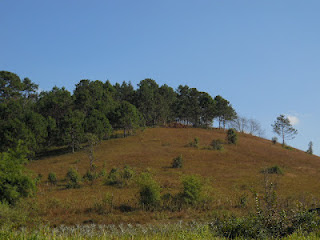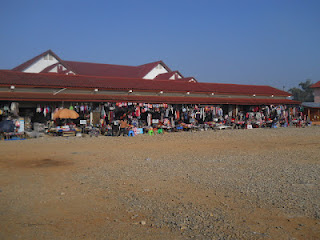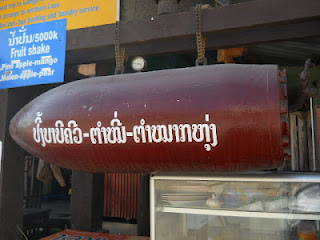 Punctually the minivan left Vangvieng bus terminal at 9:30am enroute to Phonsavan.
Punctually the minivan left Vangvieng bus terminal at 9:30am enroute to Phonsavan.There were four westerners while the rest were locals and a Lao man in uniform with cap was sitting beside me.
Shortly ten minutes into the journey,the minivan stopped beside a primary school in Ban Huay Songao(km159) to fetch two kids who will be travelling along with their parents.
Km159 is north of Vangvieng where you have the Water Fun Park with giant swing,water slider and river plunge.
That's the tubing starting point and a venue for Wild-Wild West partying but with caution "don't drink and drive" as one is solely responsible for his own action.
Limited guesthouses in the vicinity,Lao Hao Resort,Amy Guesthouse,Greenview Guesthouse and Thavisock Khamsong.
At Ban Phou Dindeng is the Aliya Guesthouse(near Greenview Guesthouse and Organic Farm and Cafe) Km160 is near the river tributary where Nam Song and Nam Po meets.
You have the Phalai Resort here and rock climbing venue.
Between Km162/3 is the river access for kayakers.Off the main road is the ethnic school beside a Buddhist temple,VangVieng Eco Lodge and camping ground.
It will be interesting if one could rent a bicycle and cycle along the river trails in this serene countryside. Km167 is the Phone Ngam Primary School and signboard direction to Pha Tho and Kieo Cave.
Km169 is the final bicycle trail and this area is near the Tham Hoi Tham Loop and Elephant Cave beside Tham Xang Xaylam Temple.
Tham Nam is the water cave where you float inside the cave and see the beautiful rock formations of stalacmites and stalagtites.
Entrance fees:10,000 kips.
10:30am:We arrived in Kasi which is 43km from VangVieng.This small little town with a petrol station is an ideal stopover for the long distance truck drivers.
Somchith Guest House (Nang Som Jit; Route 13) Rooms US$1.50. If you find yourself in Kasi overnight, Somchith, near the noodle stands above a shop house restaurant in the middle of town, offers decent two-bed rooms with shared bath.
11:00am:Ban Phounkham town in Vieng Kham district,lunch break at one Popular Restaurant.A bowl of noodles cost 15,000 kips.

12:00noon:Had a stopover at busy Phou Khoun town,about 44km north of Kasi town.
This is the T-junction between Route 13 and Route 7 going east into Xieng Khouang Province while the north is Luang Prabang.
Muang Phou Khoun was the site of a former French fort. The brick and stucco ruins of what may have been an officers quarters (some say it was an administration office for the construction of Route 13 early in the 20th century) were still visible, overlooking a deep valley.
Each room had its own fireplace, a testimony to the areas often chilly cool-season temperatures.
The 44km section of highway between Kasi and Muang Phou Khoun, which runs along a mountain ridge with excellent views, is an area where rebel attacks have occurred years back but not now.
Farther north towards Luang Prabang the scenery becomes even more spectacular, with lots of craggy mountain peaks and among the highest limestone formations in South-East Asia - a remote and desolate landscape tailor-made for rebels.
Beginning around Km 228, you'll start getting views of Phu Pha, a craggy limestone peak considered holy to animist hill tribes and Buddhists alike, on your right.
This piece looked like the famous Indonesian layer cake but no it's the agarwood.
Agarwood or oodh (or just agar) is a dark resinous heartwood that forms in Aquilaria and Gyrinops, trees (large evergreens native to southeast Asia) when they become infected with a type of mold.
Prior to infection, the heartwood is relatively light and pale coloured, however as the infection progresses, the tree produces a dark aromatic resin in response to the attack, which results in a very dense, dark, resin embedded heartwood.
The resin embedded wood is commonly called gaharu, jinko, aloeswood, agarwood, or oud (not to be confused with 'Bakhoor') and is valued in many cultures for its distinctive fragrance, and thus is used for incense and perfumes.

These agarwood looked like first grade to me. Agarwood is said to be the most expensive wood in the world with prices over US$10,000/kg for higher quality product.
The tree has many names including eaglewood, aloeswood, gaharu (Indonesia), ood, oudh, oodh (Arabic), chen xiang (Chinese), pau d'aguila (Portuguese), bois d'aigle (French)and Adlerholz (German).
Agarwood cannot be traded internationally without a the International Trade of Endangered Species (CITES) permit .
The main importing countries are Taiwan, the UAE, Saudi Arabia and Japan .
Prices of agarwood from natural forests can exceed $10,000/kg. Cultivated agarwood from plantation trees is currently retailing at the equivalent of US$5,000/kg.
Oil prices are typically around US$8,000/kg but high quality oil can sell for over US$50,000/kg. Agarwood smoke (from burning agarwood) and oil are used as customary perfume in the Middle East.In Europe, agarwood oil is a key component in the perfume M7 by Yves Saint Laurent.
In the East, agarwood is valued in Aurvedic, Tibetan and East Asian medicine for its ability to treat a range of disorders. Agarwood is also used by Muslims, Buddhists and Hindus as incense in religious ceremonies.
Agarwood essences are used to fragrance soaps and shampoos, and the popularity of highly priced essential oils reinforces the value of agarwood derivatives.
In Taiwan agarwood is an aromatic ingredient in local wines.

3:00pm:Finally I arrived in Phonsavan's minivan terminal (about 5 hours journey)which was beside a big shopping arcade and about 3km from the main town center,a very straight stretch of wide road.
If you do not have any prebooking hotels or guesthouses like me don't worry.Representatives from the respective hotels and guesthouses will approach everyone on arrival showing their brochures and room rates.
The representatives were very diplomatic and professional leaving guests to make their own choices.Free transport provided.

I have chosen Sabaidee Guesthouse which has a fan double bed room and washroom with hotwater outside.
Room rates is 30,000 kips.
Despite the free pickup,I decided to make a leisurely walk to the guesthouse and locate myself.
The stalls and bazaar has clothings mostly for the cool season prevailing now.
Less than 2km from town center is the bus terminal compound with stalls surrounding it.
Making a survey of the buses timetable is one most important task as a backpacker to plan ahead.
Phonsavan is the provincial capital of Xieng Khouang Province.
Here they list it as Xieng Khouang to the following destinations: -airbus here denotes non aircon,get outside fresh air.
Vientiane by airbus,110,000 kips available 07:00,08:00,10:30,18:40,20:00(VIP=130,000kips)
Luang Prabang and Vangvieng ,90,000 kips only one each at 07:30am.
To Xam Neua by small bus at 07:00am.
Xieng Khouang Hotel is the first sight of a modern building on reaching the town centre which faces a T-junction.
Located on the main road. Free Wi-Fi. Big rooms. Functionalist Vietnamese architecture (= very austere, extremely ugly to Western taste). US$24-30, single 150.000 kips including breakfast. Tel:+ 856 61 213 567.
After a row of shophouses with Craters Pub in the middle,a side road towards the right leads to where my planned guesthouse is located.
Craters caters to Western tastes with a menu of pizza, burgers and other favourites.
It does have a nice interior design compared to the other places in town.
Old bomb shells displayed as ornamental in front of Craters Pub also acting as a fence.
From 1964 to 1973, the U.S. flew 500,000 missions and dropped two million tons of bombs on Laos.
Neither the American people nor Congress were told about the campaign, which began in earnest in 1968, following President Lyndon B. Johnson’s announcement that all air, naval, and artillery bombardment of Vietnam would cease.
Missions were focused on two areas of Laos:
in the north they were directed against the Pathet Lao communist insurgents who were fighting the Royal Lao Army, while bombings in the south targeted the Ho Chi Minh Trail in a futile attempt to cut off supplies being delivered to North Vietnam .
260 million bombies were dropped by the USA during the Secret War in Laos, when the USA tried to secretly and futilely thwart the spread of communism in Southeast Asia.
The Secret War was covertly funded by the CIA and orchestrated by USAID in the American Embassy in Vientiane.
Unfortunately, of the 260 million bombies that were dropped, one-third were left unexploded. They lay quietly to be discovered by unsuspecting farmers trying to make a living, growing rice field and hitting a bombie while preparing their ricefield; or by innocent and naturally curious children who happened to discover a bombie that decides to activate by sudden movement (kids picking it up).





